金融学概论讲义(北大光华管理学院)lecture06
- 格式:doc
- 大小:136.00 KB
- 文档页数:40
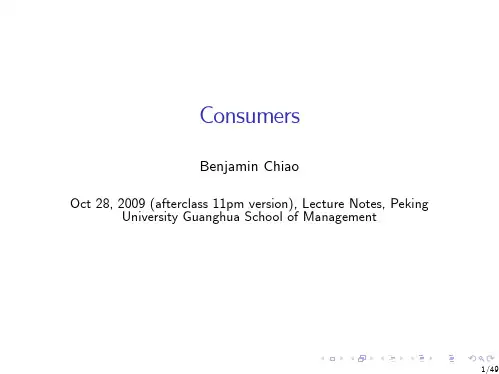
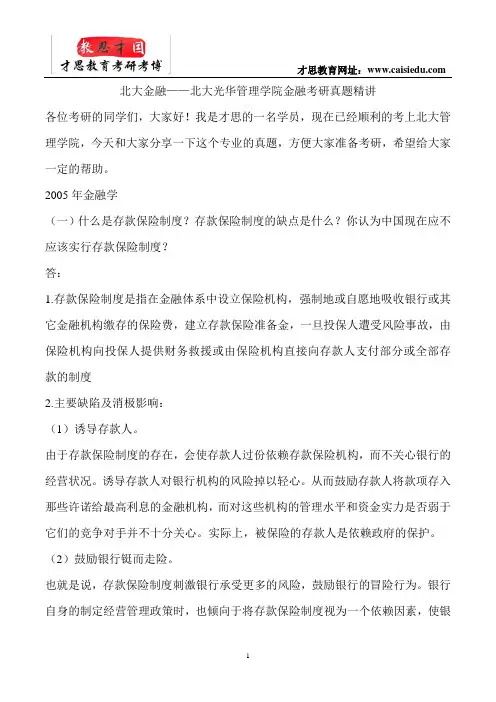
北大金融——北大光华管理学院金融考研真题精讲各位考研的同学们,大家好!我是才思的一名学员,现在已经顺利的考上北大管理学院,今天和大家分享一下这个专业的真题,方便大家准备考研,希望给大家一定的帮助。
2005年金融学(一)什么是存款保险制度?存款保险制度的缺点是什么?你认为中国现在应不应该实行存款保险制度?答:1.存款保险制度是指在金融体系中设立保险机构,强制地或自愿地吸收银行或其它金融机构缴存的保险费,建立存款保险准备金,一旦投保人遭受风险事故,由保险机构向投保人提供财务救援或由保险机构直接向存款人支付部分或全部存款的制度2.主要缺陷及消极影响:(1)诱导存款人。
由于存款保险制度的存在,会使存款人过份依赖存款保险机构,而不关心银行的经营状况。
诱导存款人对银行机构的风险掉以轻心。
从而鼓励存款人将款项存入那些许诺给最高利息的金融机构,而对这些机构的管理水平和资金实力是否弱于它们的竞争对手并不十分关心。
实际上,被保险的存款人是依赖政府的保护。
(2)鼓励银行铤而走险。
也就是说,存款保险制度刺激银行承受更多的风险,鼓励银行的冒险行为。
银行自身的制定经营管理政策时,也倾向于将存款保险制度视为一个依赖因素,使银行敢于弥补较高的存款成本而在业务活动中冒更大的风险。
因为它们知道,一旦遇到麻烦,存款保险机构会挽救它们。
特别是当一家银行出现危机而又没被关闭时,所有者便用存款保险机构的钱孤注一掷,因为这时全部的风险由承保人承担。
这样那些资金实力弱、风险程度高的金融机构会得到实际的好处,而经营稳健的银行会在竞争中受到损害,给整个金融体系注入了不稳定因素。
这与建立存款保险制度的本来目的是背道而驰的。
(3)不利于优胜劣汰。
因为管理当局对不同的有问题的银行采取不同的政策,仅有选择地允许一些银行破产,一般来说,在存款保险制度下,对一些有问题的银行可以采用三种处理方法。
一是破产清算,由存款保险机构在保险金额内支付存款人的存款;二是让有问题的银行同有偿债能力的银行合并;三是存款保险机构用存款准备金救援有问题的银行。
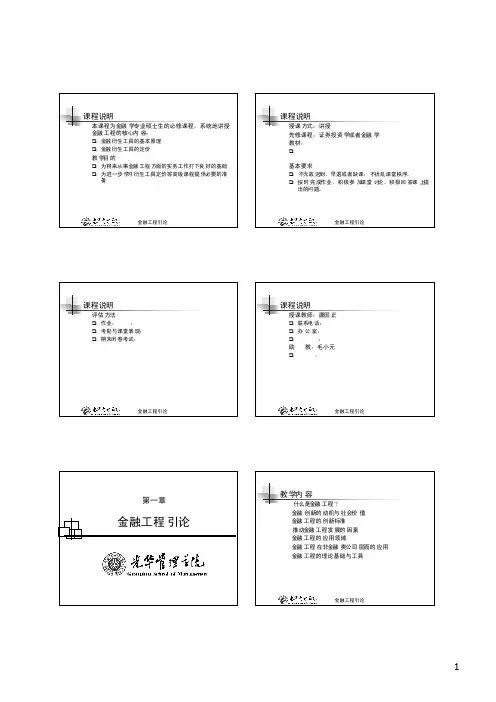
课程说明1.本课程为金融学专业硕士生的必修课程,系统地讲授课程说明1.授课方式:讲授课程说明1.评估方法课程说明1.授课教师:唐国正教学内容1.什么是金融工程?什么是金融工程?定义1.包括设计、开发和实施具有创新意义的金融工具和金什么是金融工程?创新1.创新的三个层次什么是金融工程?金融工程产品作为金融创新活动的结果,金融工程产品可能是教学内容1.什么是金融工程?金融创新的动机税法与监管的变化1.Merton Miller认为:金融创新的动机减少金融约束1.Silber认为金融创新的过程实质上是公司试图放松面金融创新的社会价值R. C. Merton认为金融创新可以从三个方面提升经济公司(RJR金融创新的社会价值零和对策?1.许多经济学家认为,从全社会的角度来看,以绕开监教学内容1.什么是金融工程?金融工程的创新标准1.一种金融工具或者金融策略成为一项金融创新的条件金融工程的创新标准1.如果用Van Horne的标准来衡量,那么一些过去被认金融工程的创新标准债权-股权互换的税收套利1.A公司:金融工程的创新标准债权-股权互换的税收套利1.这笔交易对A公司来说是有意义的教学内容1.什么是金融工程?推动金融工程发展的因素在综合了Miller、Silber与Van Horne的研究成果教学内容1.什么是金融工程?应用领域综述1.开展金融工程活动的主体应用领域融资1.在融资方面,一种类型的金融工程活动是:在各种约应用领域融资4.另一种类型的金融工程活动与公司并购有关,在并购应用领域投资与现金管理1.在投资方面,金融工程师开发出了各种各样的中长期应用领域管理发行人的风险1.在风险管理领域,金融工程发挥着重要作用应用领域管理投资者的风险1.挑战性q90年代市场上出现的与股票指数挂钩的债券应用领域风险管理管理投资者的风险与管理发行人的风险迥然不同应用领域套利1.开发交易策略来利用不同地点、不同时间、不同工具教学内容1.什么是金融工程?应用领域非金融类公司1.金融工程在公司层面有着非常重要的应用应用领域非金融类公司1.对公司来说,金融工程可以用来应用领域非金融类公司安然公司(Enron) 应用领域非金融类公司1.1993年,为了便于供应商与最终消费者管理价格风教学内容1.什么是金融工程?理论基础1.作为一门应用学科,金融工程的理论基础主要来自于基本工具1.金融工程的工具可以分成两部分,一部分是基本的金来,用以实现某一特定的目标其它理论、工具1.除了应用上述理论与工具以外,金融工程活动常常还。
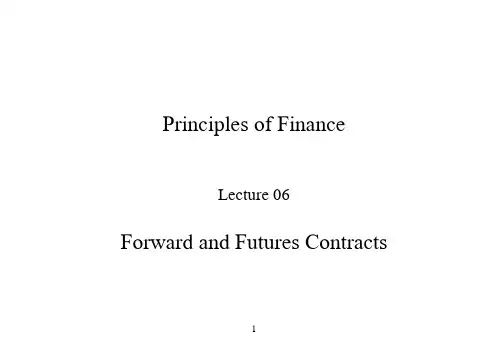
Principles of FinanceLecture 06Forward and Futures ContractsThe Nature of Derivatives∙ A derivative is an instrument whose value depends on the values of other more basic underlying variables∙Examples of derivatives-F orward-F utures-O ptions-S waps……Derivative Markets ∙Exchange Traded-Standard products-Trading floor or computer trading-Virtually no credit risk∙Over-the-Counter (OTC)-Non-standard products-Telephone market-Credit riskForward Contracts∙ A forward contract is an agreement made today to buy or sell an asset at a certain time in the future for a certain price (referred to as the forward price or the delivery price)∙The delivery price is usually chosen so that the initial value of the contract is zero; No money changes hands when contract is first negotiated and it is settled at maturity∙An OTC agreement between two parties and both parties are subject to credit risk∙Both parties have the obligation to honor the contractSettlement of Forward Contracts∙Physical: requires delivery of actual assets∙ Cash settled: requires only the exchange of the difference between the delivery price and the prevailing spot price at maturity∙Suppose that:Long 3-month Gold forwardDelivery price $300Spot price at t = 3 months: $320P/L from a Long Forward PositionS, TP/L from a Short Forward PositionSTFutures Contract∙Futures are standardized forward contracts.∙Whereas a forward contract is traded OTC a futures contract is traded on an exchange∙Specifications need to be defined:-The underlying asset-Delivery location-Maturity date and delivery time-Method of settlement∙Most contracts are closed out before maturityFeatures Promoting Liquidity ∙Standardized Contract-Maturity dates-Contract size-Price tick size, i.e. minimum price movement-The underlying asset (especially commodities) ∙Organized exchangesFeatures Reducing Credit Risk∙Daily settlement: Futures contracts are marked to market and settled at the end of every business day∙Margin account: To buy or sell a futures contract, the investor is required to post a specified margin to guarantee contract performance∙Clearinghouse: The clearinghouse does not take a position in any trade but interpose itself between two parties in every transactionMargin Accounts∙ A margin is cash or marketable securities deposited by an investor with his or her broker∙The balance in the margin account is adjusted to reflect daily settlement (profit or loss)∙Initial margin: The amount a trader must deposit into his/her trading account (i.e. margin account) when establishing a futures position∙When the balance in the margin account falls to, or below, a maintenance margin level, the trader receives a margin call and is requested to top up the account to the initial level. The extra funds deposited are known as a variation margin∙If the balance in the margin account exceeds the initial margin level, the trader is entitled to withdraw the excess funds in the accountExample of the Margin Account ∙An investor takes long position in $/£ futures∙Contract size: £62,500∙Initial margin: 1,485$∙Maintenance margin: 1,100$Date SettlementPrice OpeningBalance($)DailyP/L ($)ClosingBalance($)Margincall ($)Cumulative P/L ($)1.6500 1,48501/11 1.6508 1,485 50 1,535 50 02/11 1.6412 1,535 -600 935 550 -550 03/11 1.6384 1,485 -175 1,310 -725 04/11 1.6456 1,310 450 1,760 -275 05/11 1.6492 1,760 225 1,985 -50The Economic Function of Futures MarketsThe futures markets facilitate the re-allocation of exposure to commodity price risk among market participants.By providing a means to hedge the price risk associated with storing a commodity, futures contracts make it possible to separate the decision of whether to physically store a commodity from the decision to have financial exposure to price changes.The Economic Function of Futures MarketsThe existence of the futures market for wheat conveys information to all producers, distributors, and consumers; and this eliminates the necessity for market participants to gather and process information in order to forecast the future spot priceSuppose the commodity is wheat, and next year’s crop is expected to be much higher than average, then futures prices may be lower than the spot, (the spread may be negative,) nobody will store wheat.The Law of One Price and Arbitrage∙In a competitive market, if two assets are equivalent they will tend to have the same price∙The law of one price is enforced by a process called arbitrage∙Arbitrage is the purchasing of a set of assets, and immediate sale of another set of assets, in such a way as to earn a sure profit from price differences∙Arbitrage process brings two equivalent assets to the same price, this is known as market clearing.An Arbitrage Opportunity?∙Shares of General Motors (GM) are listed on both NYSE and LSE ∙The quoted price is £100 in London and $148 in New York∙The current exchange rate is $1.4500/£∙An arbitrage opportunity?Another Arbitrage Opportunity?∙There are two investment portfolios: portfolio A and portfolio B∙The payoffs at maturity are as follows:State 1 State 2Portfolio A $70 $100Portfolio B $70 $100∙The current quoted price of portfolio A is $80 and the current quoted price for portfolio B is $82∙An arbitrage opportunity?Framework for Forward/Future Pricing ∙Future price: price of the future∙Spot price: price of the underlying asset at present∙Future spot price: price of the underlying asset in the futureFramework for Forward/Future Pricing Suppose you have some spare cash, and you want to invest it in gold in a year’s time. There are 2 ways to do it:A.Buy gold at the spot price with your money, store it for a year(which means you incur some storage costs), sell it at the future spot price.B.Enter into a forward/future contract of gold, put your money in abank for a year, buy A at the forward/future price in the end of the year, sell it at the future spot price.Since the two strategies are equivalent, they must provide the same return so that there are no arbitrage opportunities.Framework for Forward/Future PricingDenote S as the spot price of gold, F as the forward/future price of gold, FS as the future spot price of gold, s as the storage cost of gold as a fraction of spot price, r as the risk-free interest rate:Return of A: FS S s S -- Return of B: FS FrS -+FS S FS Fs rS S---=+Therefore: (1)F r s S =++Framework for Forward/Future Pricing∙Forward price must be arbitrage-free∙Suppose that-The spot price of gold is US$300-The 1-year US$ interest rate is 8% per annum with annual compounding-Storage costs 2% of gold.-The forward-spot-price-parity relation implies that the one-year forward price is:+=++F⨯rs=S+08)30033002.0)1(.01(=∙Forward prices above $330 permit arbitrage-Suppose the forward price is $340-At time t = 0- Sell gold forward at $340- Borrow $300 at 8% pa- Purchase gold in the spot market at $300, store for a year (storage costs $6)-At time t = 1 year- Deliver gold and receive $340-Pay back loan with interest ($324)-Pay storage cost: ($6)- Make a profit of $10: 340-324-6=10∙Forward prices below $330 permit arbitrage-Suppose the forward price is $320-At time t = 0-Buy gold forward at $320-Sell short gold in the spot market at $300 (borrow gold and sell it immediately)-Deposit $300 at 8% pa-At time t = 1 year-Accept delivery of gold for $320: ($320)-Return the gold and receive storage cost: $6-Receive deposit with interest of $324-Make a profit of $10: 324+6-320=10Financial FuturesThe underlying asset of a financial future is a financial instrument, e.g. stock, bond, foreign currency, etc.Example: Share A has a spot price of $100 (S=100), the risk-free interest rate is 8% (r=0.08) with annual compounding, what’s the forward price?Forward-spot-price-parity for a share with no dividend with maturity of T years:T1(+=SrF)Financial FuturesThe investor has two equivalent investment strategies:1.buy one share A, hold it for a year, and sell it at the future spotprice of 1S. Cash flow in a year’s time: 1S2.buy a forward/future contract of share A at the price of F, make adeposit in a risk-free asset with future value of F, take the money out after a year, and buy the share at F, sell it in the market at the future spot price of 1S. Cash flow in a year’s time: 1SThe law of one price says that they should have the same price today since they produce the same amount of cash flow in a year’s time!Financial FuturesPrice of strategy 1: the spot price of share A: SPrice of strategy 2: the amount of cash invested into the risk-free asset so as to generate F in a year’s time: F/(1+r)Therefore: S=F/(1+r)Rearranging, we have:F+=S)1(rIf the futures contract matures in T years, it becomes:T=1(+rSF)Financial FuturesWhat if share A pays dividend of D in a year’s time?Again the investor has two equivalent strategies:Strategy 1: buy share A at the spot price S, hold it for one year, receive dividend of D, and sell the share at the future spot price of S. Cash flow in a year’s time: 1S+ D1Strategy 2: buy a forward/future contract at the price of F, make an investment in a risk-free asset with future value of F+D, take the money out after a year, buy the share at F, sell it in the market at the future spot price of 1S. Cash flow in a year’s time: 1S+DFinancial FuturesPrice of strategy 1: the spot price of share A: SPrice of strategy 2: the amount of cash invested into the risk-free assetso as to generate F+D in a year’s time (F+D)/(1+r)Applying the law of one price, we have: S=(F+D)/(1+r) Rearranging, we have the forward-spot-price-parity of a share with dividend payment:F=S(1+r)-DThe Forward Price is not a Forecast of Future Spot Price The forward price is obtained without risk from the current spot and risk free investmentThe spot value at a future date is obtained by investing in the security and accepting (market) risk, and this risk must be rewardedFX Forward RateDefine HC r and FC r as the effective interest rates at home andabroadFCHCr r S F ++=11where F and S are defined as the number of units of HC per unit of FC. For example, suppose £1=$1.6, then F =1.6 and $r r HC =, £r r FC = if you are buying a pound future; F =0.625 and £r r HC =, $r r FC = if you are buying a dollar future.The FX Forward RateSuppose an investor wants to buy a futures contract of pound sterling at F , i.e. he can buy pound at the price of £1=$F in a year’s time. The spot price of pound is S , i.e. £1=$S . So here pound is the foreign currency, dollar is the home currency. The risk-free interest rates are: $r r HC =, £r r FC =. What is the proper price of the future contract?The investor has two equivalent strategies: Stragegy 1:At t=0: Enter into a futures contract of pound with futures price of F . Cash flow: 0At t=1: Buy pound at F . Cash flow: FThe FX Forward RateStrategy 2:At t=0: Borrow )1/(£r S + of US dollars, change into £1/(1)r + of pounds, put it in a bank at the pound interest rate. Cash flow: 0At t=1, take the money out (in pound), pay back the dollar loan. Cashflow: $£11r Sr ++The FX Forward RateSince the two strategies both will give you one pound in a year’s time, the law of one price says that they have the same price, i.e. the amount of investment of these two strategies must be the same:$£11r F Sr +=+More generally:FCHCr r SF ++=11Pricing FX Forward Contract∙ Suppose that:Spot $/£: 1.4222One-year $ interest rate: %00.5 per annum with annual compounding One-year £ interest rate: %00.6 per annum with annual compounding∙ The six-month £ forward rate:415.10296.010247.014222.11111£$=++⨯=++=++=r r S r r S F FC HCAs a rule of thumb, if the foreign currency offers a higher interest rate, the future price of the foreign currency will be lower than the spot price.Corporate Applications: Hedging∙Receive FC payment at a future date ⇒ sells FC forward short∙Boeing has just sold 10 Boeing-747s to British Airways with total price of £200m payable in one year’s time∙Boeing can hedge this cash flow in £ by selling £ forward short∙If the one-year forward rate is $1.60/£, so Boeing will receive $320m no matter how exchange rate $/£ movesCorporate Applications: Hedging∙Make FC payment at a future date ⇒ buys FC forward (long)∙An US company imported some goods from Switzerland and is due to pay SFr100m in six months’ time∙The company can hedge its exposure to SFr by buying SFr forward. The six-month forward rate is SFr1.54/$, so the company is required to pay $64.94mThe Role of Expectations in Determining Exchange Rates Consider a world in which there are two countries, Domestic & Foreign, and conditions are such in each country that the yield curves are flat, with yields of 5% and 10% respectively.Further assume that the exchange rate is 1 todayThe 1-year forward is 1*1.05/1.10=0.9545The Role of Expectations in Determining Exchange Rates If the interest rate in Foreign is higher than in Domestic, one explanation may be that the rate of inflation is higher.Assume no taxes, and the interest rate difference is the result inflation being 5% and 10% respectively.Then the price dynamics of both countries will result in an exchange rate of 0.9545 next year, which is also the forward rate.The Role of Expectations in Determining Exchange Rates In real life, things are not so simple, but several mechanisms may be postulated that support the expectations hypothesis.International investor confidence, and their forecasts of inflation, place price pressure on both spot and forward exchange rates through the international bond market。

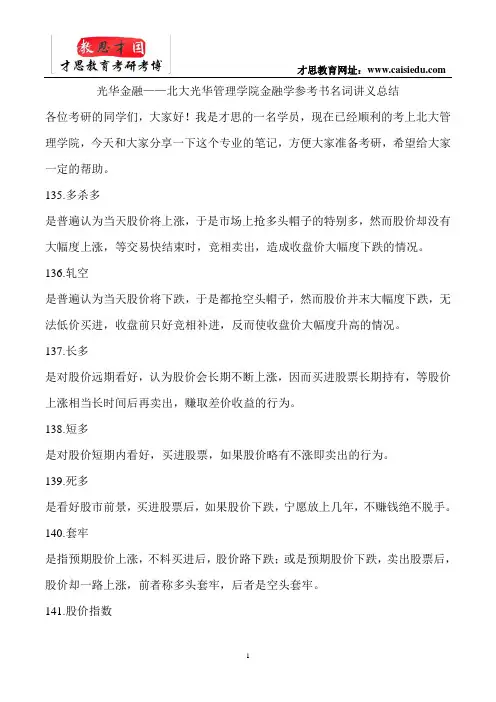
光华金融——北大光华管理学院金融学参考书名词讲义总结各位考研的同学们,大家好!我是才思的一名学员,现在已经顺利的考上北大管理学院,今天和大家分享一下这个专业的笔记,方便大家准备考研,希望给大家一定的帮助。
135.多杀多是普遍认为当天股价将上涨,于是市场上抢多头帽子的特别多,然而股价却没有大幅度上涨,等交易快结束时,竞相卖出,造成收盘价大幅度下跌的情况。
136.轧空是普遍认为当天股价将下跌,于是都抢空头帽子,然而股价并末大幅度下跌,无法低价买进,收盘前只好竞相补进,反而使收盘价大幅度升高的情况。
137.长多是对股价远期看好,认为股价会长期不断上涨,因而买进股票长期持有,等股价上涨相当长时间后再卖出,赚取差价收益的行为。
138.短多是对股价短期内看好,买进股票,如果股价略有不涨即卖出的行为。
139.死多是看好股市前景,买进股票后,如果股价下跌,宁愿放上几年,不赚钱绝不脱手。
140.套牢是指预期股价上涨,不料买进后,股价路下跌;或是预期股价下跌,卖出股票后,股价却一路上涨,前者称多头套牢,后者是空头套牢。
141.股价指数股价指数是运用统计学中的指数方法编制而成的。
反映股中总体价格或某类股价变动和走势的指标。
根据股价指数反映的价格走势所涵盖的范围,可以将股价指数划分为反映整个市场走势的综合性指数和反映某一行业或某一类股票价格上势的分类指数。
股价指数的计算方法,有算术平均法和加权平均法两种。
算术平均法,是将组成指数的每只股票价格进行简单平均,计算得出一个平均值。
加权平均法,就是在计算股价个均值时,不仅考虑到每只股票的价格,还要根据每只股票对市场影响的大小,对平均值进行调整。
实践中,一般是以股票的发行数量或成交量作为市场影响参考因素,纳入指数计算,称为权数。
由于以股票实际平均价格作为指数不便于人们计算和使用,一般很少直接用平均价来表水指数水平。
而是以某一基准日的平均价格为基准,将以后各个时期的平均价格与基准日平均价格相比较。



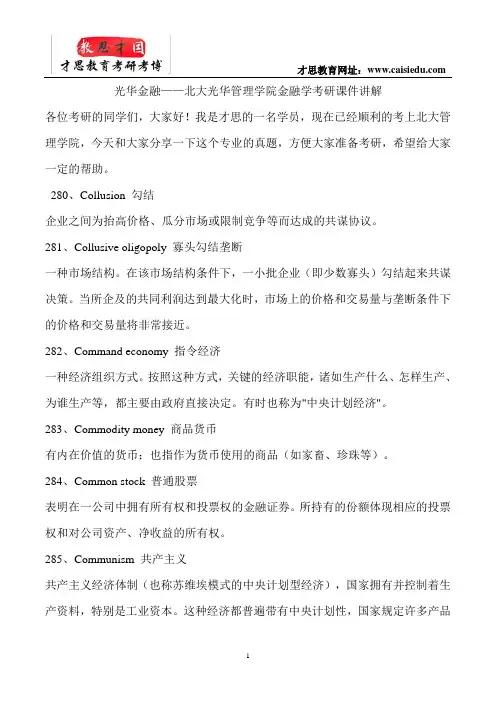
光华金融——北大光华管理学院金融学考研课件讲解各位考研的同学们,大家好!我是才思的一名学员,现在已经顺利的考上北大管理学院,今天和大家分享一下这个专业的真题,方便大家准备考研,希望给大家一定的帮助。
280、Collusion 勾结企业之间为抬高价格、瓜分市场或限制竞争等而达成的共谋协议。
281、Collusive oligopoly 寡头勾结垄断一种市场结构。
在该市场结构条件下,一小批企业(即少数寡头)勾结起来共谋决策。
当所企及的共同利润达到最大化时,市场上的价格和交易量与垄断条件下的价格和交易量将非常接近。
282、Command economy 指令经济一种经济组织方式。
按照这种方式,关键的经济职能,诸如生产什么、怎样生产、为谁生产等,都主要由政府直接决定。
有时也称为"中央计划经济"。
283、Commodity money 商品货币有内在价值的货币;也指作为货币使用的商品(如家畜、珍珠等)。
284、Common stock 普通股票表明在一公司中拥有所有权和投票权的金融证券。
所持有的份额体现相应的投票权和对公司资产、净收益的所有权。
285、Communism 共产主义共产主义经济体制(也称苏维埃模式的中央计划型经济),国家拥有并控制着生产资料,特别是工业资本。
这种经济都普遍带有中央计划性,国家规定许多产品的价格、产量和其他重要经济指标。
286、Comparative advantage(in international trade)(国际贸易中的)比较优势比较优势法则指出:一国应专门生产和出口那些该国能以相对低的成本生产的商品,并进口那些自己生产成本相对高的商品。
由此可见,是比较优势而不是绝对优势在影响贸易格局。
287、Compensating differentials 补偿性(工资)差异用于抵消或补偿工作的非货币性差异的工资水平的差别。
例如,同样的工作,在阿拉斯加环境恶劣,因而其工资要比在发达地区支付得高得多。
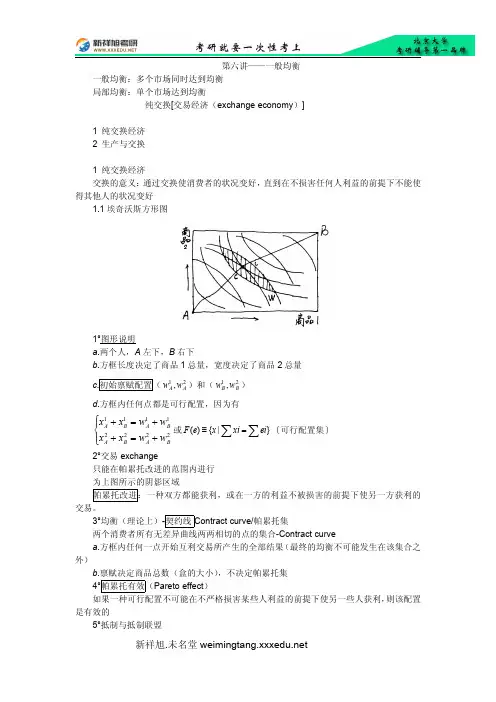
北大光华管理学院考研辅导班课件讲解各位考研的同学们,大家好!我是才思的一名学员,现在已经顺利的考上北大管理学院,今天和大家分享一下这个专业的笔记,方便大家准备考研,希望给大家一定的帮助。
金融衍生工具类23.金融衍生工具通常是指从原生资产(Underlying Asserts)派生出来的金融工具。
由于许多金融衍生产品交易在资产负债表上没有相应科目,因而也被称为“资产负债表外交易(简称表外交易)”。
根据产品形态,可以分为远期、期货、期权和掉期四大类。
24.掉期合约掉期合约是一种内交易双方签订的在未来某一时期相互交换某种资产的合约。
更为准确他说,掉期合约是当事人之间签讨的在未来某一期间内相互交换他们认为具有相等经济价值的现金流(Cash Flow)的合约。
25.期权合约期权的买方向卖方支付一定数额的权利金后,就获得这种权利,即拥有在一定时间内以一定的价格(执行价格〕出售或购买一定数量的标的物(实物商品、证券或期货合约)的权利。
26.期货合约期货合约指由期货交易所统一制订的、规定在将来某一特定的时间和地点交割一定数量和质量实物商品或金融商品的标准化合约。
27.商品期货商品期货是指标的物为实物商品的期货合约。
商品期货历史悠久,种类繁多,主要包括农副产品、金属产品、能源产品等几大类。
28.金融期货指以金融工具为标的物的期货合约。
金融期货作为期货交易中的一种,具有期货交易的一般特点,但与商品期货相比较,其合约标的物不是实物商品,而是传统的金融商品。
29.利率期货利率期货,指以利率为标的物的期货合约。
利率期货主要包括以长期国债为标的物的长期利率期货和以二个月短期存款利率为标的物的短期利率期货。
30.货币期货货币期货,指以汇率为标的物的期货合约。
货币期货是适应各国从事对外贸易和金融业务的需要而产生的,目的是借此规避汇率风险。
31.股票指数期货股票指数期货指以股票指数为标的物的期货合约。
股票指数期货不涉及股票本身的交割,其价格根据股票指数计算,合约以现金清算形式进行交割。
北京大学光华管理学历年真题解析(金融学部分)一、2006年金融学(一)写出货币乘数公式,说明在货币创造过程中参与各方如何对货币乘数产生影响。
答:货币乘数的公式为mm=1+1/1+cu+re+f,其中mm为货币乘数,cu为通货-存款比率,re为存款准备金比率,f为流出比率。
在货币的创造过程中,参与的各方包括,一般公众、企业、商业银行以及中央银行。
一般公众在货币的创造过程中,主要是持有通货,对通货-存款比率产生影响。
相对于存款,公众的支付习惯、取得现金的成本和取得方便与否影响公众手中持有的现金,从而影响通货-存款比率。
例如:如果附近有自动取款机,个人将平均携带较少的现金,因为用完现金的成本较低。
另外,通过-存款比率具有很强的季节性特点,在一些特定的时节,比如西方的圣诞节,我国的春节前后,比率会比较高。
改写货币乘数公式为mm=1+(1-re)/(re+cu)可知通过-存款比率上升会减少货币乘数。
存款准备金包括法定存款准备金和银行自己持有的超额准备金,法定存款准备金率由中央银行规定,而超额的准备金由银行自身根据经营状况,金融市场整体风险自行决定。
当然,由于持有准备金是有成本的,贷款利率即持有准备金的机会成本,因此银行会在尽可能少的持有准备金所导致的风险和多持有准备金所导致的利率损失两者进行权衡,在可以承受的风险条件下,近可能的少持有超额准备金。
银行持有的超额准备金会影响准备金-存款比率,进而影响货币乘数。
在货币创造过程中,中央银行不仅可以改变基础货币存量进而创造货币,也对货币乘数产生重要的影响。
首先中央银行可以通过规定法定存款准备金率来极大的影响货币乘数。
中央银行对法定存款准备金率的改变可以直接反映到银行的经营决策中,甚至迫使银行改变经营策略,这一手段能直接、迅速地起到作用,但是它可能会引起金融系统的巨大波动,因此并不经常使用。
其次中央银行还可以通过贴现率等手段影响银行和公众的行为,进而影响货币乘数。
不管是银行或是中央银行的行为中,对准备金-存款比率产生的影响,通过-存款比率的增加将减小货币乘数。
北大光华管理学院参考书讲义各位考研的同学们,大家好!我是才思的一名学员,现在已经顺利的考上北大管理学院,今天和大家分享一下这个专业的笔记,方便大家准备考研,希望给大家一定的帮助。
一、《微观经济学名词集锦》1.微观经济学(Microeconomics)微观经济学是经济学的一部分,它分析像消费者、厂商和资源所有者这些个体的经济行为(宏观经济学与之相反,它分析像国内总产品这样的经济总体行为)2.需求消费者在一定时期内在各种可能的价格水平下愿意而且能够购买的该商品的数量。
3.供给生产者在一定时期内在各种可能的价格水平下愿意而且能够出售的该种商品的数量。
4.均衡价格均衡的最一般意义是指经济事物中有关的变量在一定条件下的相互作用下所达到的一种相对静止的状态。
均衡价格是指该种商品的市场需求量和市场供给量相等时候的价格。
5.消费者剩余消费者在购买一定数量的某种商品时愿意支付的总数量和实际支付的总数量之间的差额。
6.生产者剩余生产者剩余指厂商在提供一定数量的某种产品时实际接受的总支付和愿意接受的最小总支付之间的差额。
7.需求的价格弹性表示在一定时期内一种商品需求量变动对于该商品的价格变动的反应程度。
8.需求的收入弹性表示在一定时期内消费者对某种商品的需求量的变动对于消费者收入两变动的反应程度。
9.需求的交叉弹性表示在一定时期内一种商品的需求量的变动对于它的相关商品的价格的变动的反应程度。
是该商品的需求量的变动率和它的相关商品的价格的变动率的比值。
10.供给的价格弹性表示在一定时期内一种商品的供给量的变动对于该商品的价格的变动的反应程度。
才思教育机构。
Principles of FinanceLecture 06Forward and Futures ContractsThe Nature of Derivatives∙ A derivative is an instrument whose value depends on the values of other more basic underlying variables∙Examples of derivatives-F orward-F utures-O ptions-S waps……Derivative Markets ∙Exchange Traded-Standard products-Trading floor or computer trading-Virtually no credit risk∙Over-the-Counter (OTC)-Non-standard products-Telephone market-Credit riskForward Contracts∙ A forward contract is an agreement made today to buy or sell an asset at a certain time in the future for a certain price (referred to as the forward price or the delivery price)∙The delivery price is usually chosen so that the initial value of the contract is zero; No money changes hands when contract is first negotiated and it is settled at maturity∙An OTC agreement between two parties and both parties are subject to credit risk∙Both parties have the obligation to honor the contractSettlement of Forward Contracts∙Physical: requires delivery of actual assets∙ Cash settled: requires only the exchange of the difference between the delivery price and the prevailing spot price at maturity∙Suppose that:Long 3-month Gold forwardDelivery price $300Spot price at t = 3 months: $320P/L from a Long Forward PositionS, TP/L from a Short Forward PositionSTFutures Contract∙Futures are standardized forward contracts.∙Whereas a forward contract is traded OTC a futures contract is traded on an exchange∙Specifications need to be defined:-The underlying asset-Delivery location-Maturity date and delivery time-Method of settlement∙Most contracts are closed out before maturityFeatures Promoting Liquidity ∙Standardized Contract-Maturity dates-Contract size-Price tick size, i.e. minimum price movement-The underlying asset (especially commodities) ∙Organized exchangesFeatures Reducing Credit Risk∙Daily settlement: Futures contracts are marked to market and settled at the end of every business day∙Margin account: To buy or sell a futures contract, the investor is required to post a specified margin to guarantee contract performance∙Clearinghouse: The clearinghouse does not take a position in any trade but interpose itself between two parties in every transactionMargin Accounts∙ A margin is cash or marketable securities deposited by an investor with his or her broker∙The balance in the margin account is adjusted to reflect daily settlement (profit or loss)∙Initial margin: The amount a trader must deposit into his/her trading account (i.e. margin account) when establishing a futures position∙When the balance in the margin account falls to, or below, a maintenance margin level, the trader receives a margin call and is requested to top up the account to the initial level. The extra funds deposited are known as a variation margin∙If the balance in the margin account exceeds the initial margin level, the trader is entitled to withdraw the excess funds in the accountExample of the Margin Account ∙An investor takes long position in $/£ futures∙Contract size: £62,500∙Initial margin: 1,485$∙Maintenance margin: 1,100$Date SettlementPrice OpeningBalance($)DailyP/L ($)ClosingBalance($)Margincall ($)Cumulative P/L ($)1.6500 1,48501/11 1.6508 1,485 50 1,535 50 02/11 1.6412 1,535 -600 935 550 -550 03/11 1.6384 1,485 -175 1,310 -725 04/11 1.6456 1,310 450 1,760 -275 05/11 1.6492 1,760 225 1,985 -50The Economic Function of Futures MarketsThe futures markets facilitate the re-allocation of exposure to commodity price risk among market participants.By providing a means to hedge the price risk associated with storing a commodity, futures contracts make it possible to separate the decision of whether to physically store a commodity from the decision to have financial exposure to price changes.The Economic Function of Futures MarketsThe existence of the futures market for wheat conveys information to all producers, distributors, and consumers; and this eliminates the necessity for market participants to gather and process information in order to forecast the future spot priceSuppose the commodity is wheat, and next year’s crop is expected to be much higher than average, then futures prices may be lower than the spot, (the spread may be negative,) nobody will store wheat.The Law of One Price and Arbitrage∙In a competitive market, if two assets are equivalent they will tend to have the same price∙The law of one price is enforced by a process called arbitrage∙Arbitrage is the purchasing of a set of assets, and immediate sale of another set of assets, in such a way as to earn a sure profit from price differences∙Arbitrage process brings two equivalent assets to the same price, this is known as market clearing.An Arbitrage Opportunity?∙Shares of General Motors (GM) are listed on both NYSE and LSE ∙The quoted price is £100 in London and $148 in New York∙The current exchange rate is $1.4500/£∙An arbitrage opportunity?Another Arbitrage Opportunity?∙There are two investment portfolios: portfolio A and portfolio B∙The payoffs at maturity are as follows:State 1 State 2Portfolio A $70 $100Portfolio B $70 $100∙The current quoted price of portfolio A is $80 and the current quoted price for portfolio B is $82∙An arbitrage opportunity?Framework for Forward/Future Pricing ∙Future price: price of the future∙Spot price: price of the underlying asset at present∙Future spot price: price of the underlying asset in the futureFramework for Forward/Future Pricing Suppose you have some spare cash, and you want to invest it in gold in a year’s time. There are 2 ways to do it:A.Buy gold at the spot price with your money, store it for a year(which means you incur some storage costs), sell it at the future spot price.B.Enter into a forward/future contract of gold, put your money in abank for a year, buy A at the forward/future price in the end of the year, sell it at the future spot price.Since the two strategies are equivalent, they must provide the same return so that there are no arbitrage opportunities.Framework for Forward/Future PricingDenote S as the spot price of gold, F as the forward/future price of gold, FS as the future spot price of gold, s as the storage cost of gold as a fraction of spot price, r as the risk-free interest rate:Return of A: FS S s S -- Return of B: FS FrS -+FS S FS Fs rS S---=+Therefore: (1)F r s S =++Framework for Forward/Future Pricing∙Forward price must be arbitrage-free∙Suppose that-The spot price of gold is US$300-The 1-year US$ interest rate is 8% per annum with annual compounding-Storage costs 2% of gold.-The forward-spot-price-parity relation implies that the one-year forward price is:+=++F⨯rs=S+08)30033002.0)1(.01(=∙Forward prices above $330 permit arbitrage-Suppose the forward price is $340-At time t = 0- Sell gold forward at $340- Borrow $300 at 8% pa- Purchase gold in the spot market at $300, store for a year (storage costs $6)-At time t = 1 year- Deliver gold and receive $340-Pay back loan with interest ($324)-Pay storage cost: ($6)- Make a profit of $10: 340-324-6=10∙Forward prices below $330 permit arbitrage-Suppose the forward price is $320-At time t = 0-Buy gold forward at $320-Sell short gold in the spot market at $300 (borrow gold and sell it immediately)-Deposit $300 at 8% pa-At time t = 1 year-Accept delivery of gold for $320: ($320)-Return the gold and receive storage cost: $6-Receive deposit with interest of $324-Make a profit of $10: 324+6-320=10Financial FuturesThe underlying asset of a financial future is a financial instrument, e.g. stock, bond, foreign currency, etc.Example: Share A has a spot price of $100 (S=100), the risk-free interest rate is 8% (r=0.08) with annual compounding, what’s the forward price?Forward-spot-price-parity for a share with no dividend with maturity of T years:T1(+=SrF)Financial FuturesThe investor has two equivalent investment strategies:1.buy one share A, hold it for a year, and sell it at the future spotprice of 1S. Cash flow in a year’s time: 1S2.buy a forward/future contract of share A at the price of F, make adeposit in a risk-free asset with future value of F, take the money out after a year, and buy the share at F, sell it in the market at the future spot price of 1S. Cash flow in a year’s time: 1SThe law of one price says that they should have the same price today since they produce the same amount of cash flow in a year’s time!Financial FuturesPrice of strategy 1: the spot price of share A: SPrice of strategy 2: the amount of cash invested into the risk-free asset so as to generate F in a year’s time: F/(1+r)Therefore: S=F/(1+r)Rearranging, we have:F+=S)1(rIf the futures contract matures in T years, it becomes:T=1(+rSF)Financial FuturesWhat if share A pays dividend of D in a year’s time?Again the investor has two equivalent strategies:Strategy 1: buy share A at the spot price S, hold it for one year, receive dividend of D, and sell the share at the future spot price of S. Cash flow in a year’s time: 1S+ D1Strategy 2: buy a forward/future contract at the price of F, make an investment in a risk-free asset with future value of F+D, take the money out after a year, buy the share at F, sell it in the market at the future spot price of 1S. Cash flow in a year’s time: 1S+DFinancial FuturesPrice of strategy 1: the spot price of share A: SPrice of strategy 2: the amount of cash invested into the risk-free assetso as to generate F+D in a year’s time (F+D)/(1+r)Applying the law of one price, we have: S=(F+D)/(1+r) Rearranging, we have the forward-spot-price-parity of a share with dividend payment:F=S(1+r)-DThe Forward Price is not a Forecast of Future Spot Price The forward price is obtained without risk from the current spot and risk free investmentThe spot value at a future date is obtained by investing in the security and accepting (market) risk, and this risk must be rewardedFX Forward RateDefine HC r and FC r as the effective interest rates at home andabroadFCHCr r S F ++=11where F and S are defined as the number of units of HC per unit of FC. For example, suppose £1=$1.6, then F =1.6 and $r r HC =, £r r FC = if you are buying a pound future; F =0.625 and £r r HC =, $r r FC = if you are buying a dollar future.The FX Forward RateSuppose an investor wants to buy a futures contract of pound sterling at F , i.e. he can buy pound at the price of £1=$F in a year’s time. The spot price of pound is S , i.e. £1=$S . So here pound is the foreign currency, dollar is the home currency. The risk-free interest rates are: $r r HC =, £r r FC =. What is the proper price of the future contract?The investor has two equivalent strategies: Stragegy 1:At t=0: Enter into a futures contract of pound with futures price of F . Cash flow: 0At t=1: Buy pound at F . Cash flow: FThe FX Forward RateStrategy 2:At t=0: Borrow )1/(£r S + of US dollars, change into £1/(1)r + of pounds, put it in a bank at the pound interest rate. Cash flow: 0At t=1, take the money out (in pound), pay back the dollar loan. Cashflow: $£11r Sr ++The FX Forward RateSince the two strategies both will give you one pound in a year’s time, the law of one price says that they have the same price, i.e. the amount of investment of these two strategies must be the same:$£11r F Sr +=+More generally:FCHCr r SF ++=11Pricing FX Forward Contract∙ Suppose that:Spot $/£: 1.4222One-year $ interest rate: %00.5 per annum with annual compounding One-year £ interest rate: %00.6 per annum with annual compounding∙ The six-month £ forward rate:415.10296.010247.014222.11111£$=++⨯=++=++=r r S r r S F FC HCAs a rule of thumb, if the foreign currency offers a higher interest rate, the future price of the foreign currency will be lower than the spot price.Corporate Applications: Hedging∙Receive FC payment at a future date ⇒ sells FC forward short∙Boeing has just sold 10 Boeing-747s to British Airways with total price of £200m payable in one year’s time∙Boeing can hedge this cash flow in £ by selling £ forward short∙If the one-year forward rate is $1.60/£, so Boeing will receive $320m no matter how exchange rate $/£ movesCorporate Applications: Hedging∙Make FC payment at a future date ⇒ buys FC forward (long)∙An US company imported some goods from Switzerland and is due to pay SFr100m in six months’ time∙The company can hedge its exposure to SFr by buying SFr forward. The six-month forward rate is SFr1.54/$, so the company is required to pay $64.94mThe Role of Expectations in Determining Exchange Rates Consider a world in which there are two countries, Domestic & Foreign, and conditions are such in each country that the yield curves are flat, with yields of 5% and 10% respectively.Further assume that the exchange rate is 1 todayThe 1-year forward is 1*1.05/1.10=0.9545The Role of Expectations in Determining Exchange Rates If the interest rate in Foreign is higher than in Domestic, one explanation may be that the rate of inflation is higher.Assume no taxes, and the interest rate difference is the result inflation being 5% and 10% respectively.Then the price dynamics of both countries will result in an exchange rate of 0.9545 next year, which is also the forward rate.The Role of Expectations in Determining Exchange Rates In real life, things are not so simple, but several mechanisms may be postulated that support the expectations hypothesis.International investor confidence, and their forecasts of inflation, place price pressure on both spot and forward exchange rates through the international bond market。